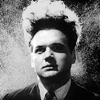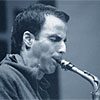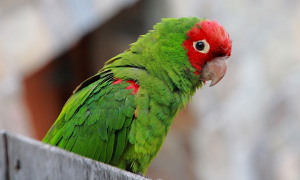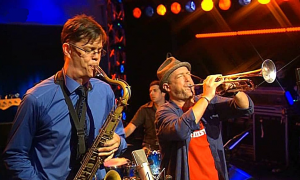Home » Jazz Articles » Genius Guide to Jazz » Hillbilly Jazz: From the Blue Ridge to Blue Note
Hillbilly Jazz: From the Blue Ridge to Blue Note
How often do we have a complete recorded history of an entire genre by the innovator himself (besides Elvis' Jumpsuit Opera period)?
 Meanwhile, in the Appalachian mountains of the South, the common balladry of the Scotch-Irish settlers who had been settling the region since the early seventeenth century had been undergoing a slow process of assimilation and was developing into a distinctive form unto its own. Known as mountain, or country music, the form was primarily vocal and strings but did not yet closely resemble its modern form because canned beer, mobile homes and pickup trucks were yet to be invented.
Meanwhile, in the Appalachian mountains of the South, the common balladry of the Scotch-Irish settlers who had been settling the region since the early seventeenth century had been undergoing a slow process of assimilation and was developing into a distinctive form unto its own. Known as mountain, or country music, the form was primarily vocal and strings but did not yet closely resemble its modern form because canned beer, mobile homes and pickup trucks were yet to be invented.With the advent of recording technology at the beginning of the twentieth century, traditional country music expanded beyond its established boundaries and found an audience all over the country wherever blue collars and red necks were allowed to roam free. Early pioneers of the recorded form included Virginia's legendary Carter family who rose from the hardscrabble coalfields to become internationally renowned thanks mostly to the talents and determination of Mother Maybelle Carter, one of the first strong female figures in music. It might be said that she was the Madonna of her age, except without the media whoredom, the crackpot views, and (thankfully) no book of featuring Mother Maybelle posing in erotic situations with Sidney Bechet and Hattie McDaniel.
 At the same time traditional country music was finding its audience, a new form was taking shape at the hands of Kentuckian Bill Monroe. After experimenting with several different lineups, at one point having the great Rogers Hornsby bat as low as seventh in the order, Monroe settled upon the now-standard instrumentation of guitar, banjo, bass, fiddle and mandolin. Since he hailed from the Bluegrass State, he decided to call his group the Blue Grass Boys. Hence, the new form they created was called Bluegrass. Fortunately for all posterity that Monroe wasn't from South Carolina, because Palmetto music just wouldn't have been taken as seriously.
At the same time traditional country music was finding its audience, a new form was taking shape at the hands of Kentuckian Bill Monroe. After experimenting with several different lineups, at one point having the great Rogers Hornsby bat as low as seventh in the order, Monroe settled upon the now-standard instrumentation of guitar, banjo, bass, fiddle and mandolin. Since he hailed from the Bluegrass State, he decided to call his group the Blue Grass Boys. Hence, the new form they created was called Bluegrass. Fortunately for all posterity that Monroe wasn't from South Carolina, because Palmetto music just wouldn't have been taken as seriously.Be that as it may.
 Though the new music made its proper debut on the stage of the iconic Grand Ole Opry in 1939, many feel that bluegrass didn't truly coalesce until 1945 with the addition of 21 year-old banjo wizard Earl Scruggs. It was his innovative, dynamic playing that gave the music the spark it needed to become a genre unto itself. Scruggs' addition to bluegrass was so profound that even now the banjo is its signature voice, and is one of two people who influenced my year-long moratorium on derisive banjo jokes (the other being Bela Fleck).
Though the new music made its proper debut on the stage of the iconic Grand Ole Opry in 1939, many feel that bluegrass didn't truly coalesce until 1945 with the addition of 21 year-old banjo wizard Earl Scruggs. It was his innovative, dynamic playing that gave the music the spark it needed to become a genre unto itself. Scruggs' addition to bluegrass was so profound that even now the banjo is its signature voice, and is one of two people who influenced my year-long moratorium on derisive banjo jokes (the other being Bela Fleck).Scruggs went on to become one of the true legends of bluegrass, both with partner Lester Flatt and as a solo artist. Crossover hits, such as "Foggy Mountain Breakdown" from the movie Bonnie and Clyde, and "The Ballad of Jed Clampett" from The Beverly Hillbillies, brought the music to the popular ear in the 1960's. Thus began a renaissance of hillbilly culture that reached its high water mark at the cut-off edge of Catherine Bach's Daisy Dukes.
Like Art Blakey did with jazz, Monroe was himself an ambassador and used his band as an incubator for the furtherance of the music he loved. Over 150 different musicians learned their craft in the Blue Grass Boys (not at the same time, of course. Just getting all the mandolins tuned up would have taken weeks), with some of the biggest names in bluegrass passing under Monroe's tutelage before going on to their own solo careers. Sonny Osborne, Del McCoury, Carter Stanley, David "Stringbean" Akeman, Mac Wiseman and Randall Franks ("Beans and Franks" jokes 3 for $10, with loyalty card) were all Blue Grass Boys at some point.
Like jazz, bluegrass first found its voice at the edges of society. Before the advent of satellite TV and the Internet, hillbillies lacked fundamental access to mainstream culture. Thus unbound by the narrow confines of the musical orthodoxy, both jazz and bluegrass expounded upon the possible rather than the acceptable. As a result, both forms encouraged exploration and improvisation. Unlike jazz, though, bluegrass also encouraged flat-footing and excessive consumption of buttermilk.
 The parallels between bluegrass and Our Music, particularly Bebop, are many. Both require a high level of technical virtuosity, both have a penchant for unique chords and breakneck changes, and both are, in their purest form, strictly acoustic. Both draw from their collective pasts to create something completely unique, and both can appeal to both the visceral and the intellectual. And most notably, both tolerate the wearing of hats that would get you laughed out of many other segments of society.
The parallels between bluegrass and Our Music, particularly Bebop, are many. Both require a high level of technical virtuosity, both have a penchant for unique chords and breakneck changes, and both are, in their purest form, strictly acoustic. Both draw from their collective pasts to create something completely unique, and both can appeal to both the visceral and the intellectual. And most notably, both tolerate the wearing of hats that would get you laughed out of many other segments of society.Moreover, jazz and bluegrass are both caught between the pull of the traditionalists and the inevitable drift of innovation. As jazz must deal with the encroachment of electronica and urban influences, bluegrass is confronted with the dichotomy between the iconic old time music and the growing popularity of "newgrass." An outgrowth of the allure bluegrass holds for the type of folks who honestly believe that each pint of Ben and Jerry's they buy causes a tree to spontaneously pop up in the rain forest, newgrass forms a common link between two groups of people who would normally have to be separated by the state police.
Such as that is.
 Few places demonstrate the unlikely alliance between old and new as does Floyd County, practically a stone's throw from the Provisional Geniusdome. A rural mash-up of Old Virginia and New Age (think patchouli-smoked ham), Floyd Country serves as fertile soil for both the deep roots of traditional bluegrass and the emerging branches of its latest iterations. Every Friday night at the Floyd Country Store, Birkenstocks and steel-toed boots mingle freely as the store itself and the sidewalk outside are filled both with proper bands and loose, self-assembling groups of pickers fill the night air with the sounds of bluegrass, newgrass, Poohgrass (traditional music from the Hundred Acre Wood), queuegrass (where the players line up for the chance to play), and kung fugrass (a mixture of martial arts and kick-ass dobro solos).
Few places demonstrate the unlikely alliance between old and new as does Floyd County, practically a stone's throw from the Provisional Geniusdome. A rural mash-up of Old Virginia and New Age (think patchouli-smoked ham), Floyd Country serves as fertile soil for both the deep roots of traditional bluegrass and the emerging branches of its latest iterations. Every Friday night at the Floyd Country Store, Birkenstocks and steel-toed boots mingle freely as the store itself and the sidewalk outside are filled both with proper bands and loose, self-assembling groups of pickers fill the night air with the sounds of bluegrass, newgrass, Poohgrass (traditional music from the Hundred Acre Wood), queuegrass (where the players line up for the chance to play), and kung fugrass (a mixture of martial arts and kick-ass dobro solos).A full written apology for that last gag is available by sending a self-addressed, stamped envelope to the Provisional Geniusdome, C/O AAJ.
Despite the dichotomy between old and new, bluegrass manages to maintain a "Big Tent" approach that might benefit attendants of Our Music. Perhaps it is time to make room at the table for the Acid Jazz and Electronica set, and usher the Smooth Jazz crowd over to the kid's table until they put their Eric Marienthal CD's away and start acting like they've got some damned sense.
Moreover, it might just be possible that the similarities between bluegrass and Our Music can foster a mutual admiration society that will bring hipsters, hippies, and hillbillies together to join in the spirit of true brotherhood and finally knock out top-forty pop now that the Digital Revolution has it staggering on the ropes.
 To begin your journey into bluegrass, you'd do no better than the recordings of Bill Monroe. How often do we have a complete recorded history of an entire genre by the innovator himself (besides Elvis' Jumpsuit Opera period)? Of the early years, there are quite a few exceptional recordings by the Osborne Brothers, the Stanley Brothers, and Flatt and Scruggs (who were not brothers, but Earl once copped a feel off of Dr. Joyce Brothers). More contemporary artists worth a listen include Allison Krauss, Ricky Skaggs, Sam Bush (no relation to Saints RB Reggie Bush, though he does run a 4.6 forty), and the inimitable Doc Watson. Also, the soundtrack to the film O Brother, Where Art Thou, which brought a Warholian quarter-hour's worth of attention to traditional country and bluegrass, stands as a worthy starting point.
To begin your journey into bluegrass, you'd do no better than the recordings of Bill Monroe. How often do we have a complete recorded history of an entire genre by the innovator himself (besides Elvis' Jumpsuit Opera period)? Of the early years, there are quite a few exceptional recordings by the Osborne Brothers, the Stanley Brothers, and Flatt and Scruggs (who were not brothers, but Earl once copped a feel off of Dr. Joyce Brothers). More contemporary artists worth a listen include Allison Krauss, Ricky Skaggs, Sam Bush (no relation to Saints RB Reggie Bush, though he does run a 4.6 forty), and the inimitable Doc Watson. Also, the soundtrack to the film O Brother, Where Art Thou, which brought a Warholian quarter-hour's worth of attention to traditional country and bluegrass, stands as a worthy starting point.Should you find yourself wanting a more immersive experience, you can venture down here to my corner of the Commonwealth and enjoy the Crooked Road music heritage trail. Winding from the aforementioned Floyd Country Store to the stamping grounds of the aforeaforementioned Carter Family to the Blue Ridge Institute and Museum and Pit BBQ at Ferrum College & Grill (mention this article and receive your choice of a free side of cole slaw or an associates degree), the Crooked Road takes you through the heart of the land from whence the music came. It also brings you near enough to the Provisional Geniusdome that you could stop by for biscuits and gravy, if you're able to negotiate the gauntlet of booby traps leading to the front door.
So there you have it, a primer and manifesto for yet another theatre in the War Against Disposable Corporate Music. They'll never see the banjos coming.
Until next month, kids, exit to your right and enjoy the rest of AAJ.
Tags
PREVIOUS / NEXT
Support All About Jazz
 All About Jazz has been a pillar of jazz since 1995, championing it as an art form and, more importantly, supporting the musicians who make it. Our enduring commitment has made "AAJ" one of the most culturally important websites of its kind, read by hundreds of thousands of fans, musicians and industry figures every month.
All About Jazz has been a pillar of jazz since 1995, championing it as an art form and, more importantly, supporting the musicians who make it. Our enduring commitment has made "AAJ" one of the most culturally important websites of its kind, read by hundreds of thousands of fans, musicians and industry figures every month.




















